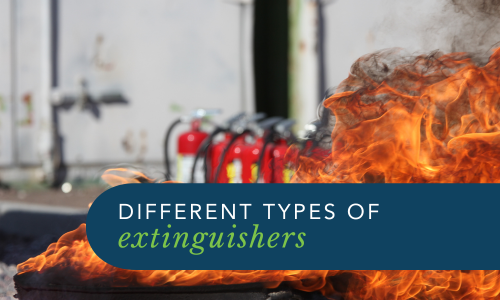Different Types of Fire Extinguishers and Why we Need them
Fire incidents present significant hazards to both life and property, highlighting the importance of implementing effective fire safety measures. Understanding the distinct types of fire extinguisher is crucial, as they are specifically designed to address fire categories. This blog aims to highlight the range of fire extinguishers based on the Australian classification system and the underlying rationale for their variations.
In Australia, fires are categorised into six classes, namely Class A, B, C, D, E, and F. Each class denotes a specific type of fire. To effectively combat fires belonging to different classes, a variety of fire extinguishers have been developed, with each type having varying levels of effectiveness on the different classes of fires. Information on the extinguishers also identifies what types of fires they can be used on.
- Water-based Fire Extinguishers (Class A) (Red Band): Fire extinguishers that use water are highly effective in extinguishing Class A fires, which typically involve materials like wood, paper and plastic that are prone to combustion. These extinguishers work by reducing the temperature of the fire (Cooling and removing the heat) and saturating the fuel source, effectively suppressing the flames. It is crucial to remember that water-based extinguishers should never be used on electrical fires or fires that involve flammable liquids and fats and oils. Water extinguishers are really only effective on Class A type fires.
- Foam-based Fire Extinguishers (Class AB) (Blue Band): Fire extinguishers with foam are suitable for extinguishing Class A and B class fires. They create a layer of foam over the burning material, which hampers the release of flammable vapours and suffocates the fire. However, foam-based extinguishers are not recommended for use on electrical fires due to the risk of electrical conductivity.
- Carbon Dioxide (CO2) Extinguishers (Class B and Class E) (Black Band): Carbon dioxide (CO2) extinguishers are primarily used and are most effective in extinguishing Class E fires that involve electrical equipment and can also be used for Class B fires associated with flammable liquids. The mechanism of action involves displacing oxygen and replacing it with the CO2, which effectively starves the fire of its necessary element. CO2 extinguishers are particularly well-suited for protecting sensitive electrical equipment since they leave no residue behind after usage. The CO2 is very cold when expelled from the extinguisher so it does have a cooling affect upon the fire as well.
- Dry Chemical Fire Extinguishers (Class A, B, E) (White Band): Dry chemical extinguishers come in two types, including ABE and BE extinguishers. They interrupt the chemical reaction of the fire and create a barrier between the fuel and oxygen. ABE extinguishers are versatile and can be used on Class A, B, and E fires, while BE extinguishers are ideal for flammable liquid and electrical fires. The ABE extinguisher has a limited effectiveness on Class C fires.
- Wet Chemical Fire Extinguishers (Class F) (Yellow/Mustard Band): Wet chemical extinguishers are specifically designed to combat Class F fires, which may occur in cooking appliances involving fats and oils. They work by cooling the fuel and creating a chemical reaction to smother the fire and extinguish it.
Using the correct types fire extinguisher is critical for effectively suppressing and extinguishing a fire. Misusing an extinguisher or choosing an inappropriate type can be ineffective or even dangerous. Proper fire safety training and awareness are essential to ensure individuals can make informed decisions during emergencies.
The range of fire extinguishers available reflects the unique nature of fire incidents and the need for targeted suppression techniques. Understanding the Australian fire classification system and the corresponding fire extinguishers is crucial for effective fire prevention and management. By selecting the appropriate extinguisher, we can enhance fire safety measures, protect lives, and safeguard property. Remember, staying prepared and informed is key to fire safety for all. Call Workplace Emergency Management today for all the information you and your workplace needs for using fire safety equipment.
For more information on Fire Training, you can visit our Fire Training page.
GET IN TOUCH
Are you ready for peace of mind that your workforce is as safe and prepared as possible?
With a dedicated team of staff ready to help you meet compliance requirements and improve the overall safety of your workplace, all you need to do is get in touch.
Request your free audit today!



